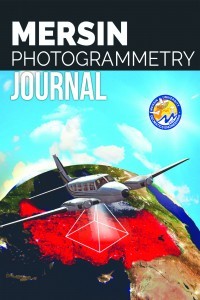MAPPING OF A ROCKFALL SITE WITH AN UNMANNED AERIAL VEHICLE
MAPPING OF A ROCKFALL SITE WITH AN UNMANNED AERIAL VEHICLE
Rockfall, Unmanned aerial vehicle,
___
- Admassu, Y., Shakoor, A. and Wells, N. A. (2012). “Evaluating selected factors affecting the depth of undercutting in rocks subject to differential weathering.” Engineering Geology, 124, 1-11.
- Agliardi, F. and Crosta, G. B. (2003). “High resolution three-dimensional numerical modelling of rockfalls.” International Journal of Rock Mechanics & Mining Sciences, 40, 455–471.
- Ansari, M. K., Ahmad, M., Singh, R. and Singh, T. N. (2018). “2D and 3D Rockfall Hazard Analysis and Protection Measures for Saptashrungi Gad Temple, Vani, Nashik, Maharashtra – A Case Study.” Journal Geological Society of India, 91, 47-56.
- Chau, K. T., Wong, R. H. C. and Wu, J. J. (2002). “Coefficient of restitution and rotational motions of rockfall impacts.” International Journal of Rock Mechanics & Mining Sciences, 39, 69–77.
- Choi, Y., Lee, J., Lee, J. and Park, H. (2009). “Engineering geological investigation into rockfall problem: A case study of the Seated Seokgayeorae Image carved on a rock face at the UNESCO World Heritage site in Korea.” Geosciences Journal, 13-1, 69 – 78.
- Corona, C., Lopez-Saez, J., Favillier, A., Mainieri, R., Eckert, N., Trappmann, D., Stoffel, M., Bourrier, F. and Berger, F. (2017). “Modeling rockfall frequency and bounce height from three dimensional simulation process models and growth disturbances in submontane broadleaved trees.” Geomorphology, 281,66–77.
- Escallon, J. P., Boetticher, V., Wendeler, C., Chatzi, E. and Bartelt, P. (2015). “Mechanics of chain-link wire nets with loose connections” Engineering Structures, 101, 68–87.
- Fanos, A.M. and Pradhan, B. (2019). “A novel rockfall hazard assessment using laser scanning data and 3D modelling in GIS.” Catena, 172, 435-450.
- Gökçe, O., Özden, Ş. and Demir, A. (2008). “Türkiye’de Afetlerin Mekansal ve İstatistiksel Dağılımı Afet Bilgileri Envanteri.” T.C Bayindirlik ve İskan Bakanliği Afet İşleri Genel Müdürlüğü Afet Etüt ve Hasar Tespit Daire Başkanlığı, ANKARA.
- Guzzetti, F., Crosta, G., Detti, R. and Agliardi, F. (2002). “STONE: a computer program for the three-dimensional simulation of rock-falls.” Computers & Geosciences, 28, 1079–1093.
- Jaboyedoff, M. and Labiouse, V. (2011). “Technical Note: Preliminary estimation of rockfall runout zones.” Natural Hazards and Earth System Sciences, 11, 819–828.
- Lan, H., Martin, C.D. and Lim, C.H. (2007). “RockFall analyst: A GIS extension for threedimensional and spatially distributed rockfall hazard modeling.” Computers & Geosciences, 33, 262–279.
- Lunina, O.V., Radziminovich, Y.B. and Gladkov, A.S. (2007). Gravity effects caused by moderate earthquakes: role of local fault pattern. Russian Geology and Geophysics, 48, 610–613.
- Matsuoka, N. and Sakai, H. (1999). “Rockfall activity from an alpine cliff during thawing periods.” Geomorphology, 28, 309–328.
- Moon, T., Oh, J. and Mun, B. (2014). “Practical design of rockfall catchfence at urban area from a numerical analysis approach.” Engineering Geology, 172, 41–56.
- Papini, M., Longoni, L. and Alba, M. (2005). “Rock falls and risk evaluation.” Safety and Security Engineering, 82, 675-685.
- Sasiharan, N., Muhunthan, B., Badger, T.C., Shu, S. and Carradine, D.M. (2006). “Numerical analysis of the performance of wire mesh and cable net rockfall protection systems.” Engineering Geology, 88, 121–132.
- Schweigl, J., Ferretti, C. and Nössing, L. (2003). “Geotechnical characterization and rockfall simulation of a slope: a practical case study from South Tyrol (Italy)” Engineering Geology, 67, 281-296.
- Simon, N., Ghani, M. F. A., Hussin, A., Lai, G. T., Rafek, A. G., Surip, N., Monam, T. R. T. and Ern, L. K. (2015). “Assessment of Rockfall Potential of Limestone Hills in the Kinta Valley.” Journal of Sustainability Science and Management, 10-2, 24-34.
- Wei, L., Chen, H., Lee, C., Huang, W., Lin, M., Chi, C and Lin, H. (2014). “The mechanism of rockfall disaster: A case study from Badouzih, Keelung, in northern Taiwan.” Engineering Geology, 183, 116–126.
- Yılmaz, I., Yıldırım, M. and Keskin, I. (2008). “A method for mapping the spatial distribution of RockFall computer program analyses results using ArcGIS software.” Bulletin of Engineering Geology and the Environment, 67, 547–554.
- Yayın Aralığı: Yılda 2 Sayı
- Başlangıç: 2019
- Yayıncı: Mersin Üniversitesi
EXCAVATION MONITORING WITH UAV IN ŞANLIURFA CASTLE ARCHAEOLOGICAL SITE
Mustafa ULUKAVAK, Abdulkadir MEMDUHOĞLU, Halil İbrahim ŞENOL, Nizar POLAT
MAPPING OF A ROCKFALL SITE WITH AN UNMANNED AERIAL VEHICLE
Aydın ALPTEKİN, Mehmet Özgür ÇELİK, Yusuf DOĞAN, Murat YAKAR
3D MODELLING OF BRIDGES BY UAV PHOTOGRAMMETRY METHOD
MODELING OF HISTORICAL FOUNTAINS BY USING CLOSE-RANGE PHOTOGRAMMETRIC TECHNIQUES
Ali ULVİ, Abdurrahman Yasin YİĞİT, Murat YAKAR
THE USE OF UAV AND PHOTOGRAMMETRY IN DIGITAL DOCUMENTATION
Mustafa ULUKAVAK, Abdulkadir MEMDUHOĞLU, Halil İbrahim ŞENOL, Nizar POLAT
